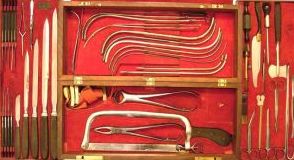Authentic Period Civil War Medical Items  Civil War Surgical Sets Medical Text Books and Surgical Manuals Articles on Civil War Medicine See our Articles On Civil War Medicine |
Synopsis of Frank Hamilton's Lecture on Military Surgery
at Bellevue Hospital Medical College on April of 1861.

Military Surgery At Bellevue Hospital April, 1861